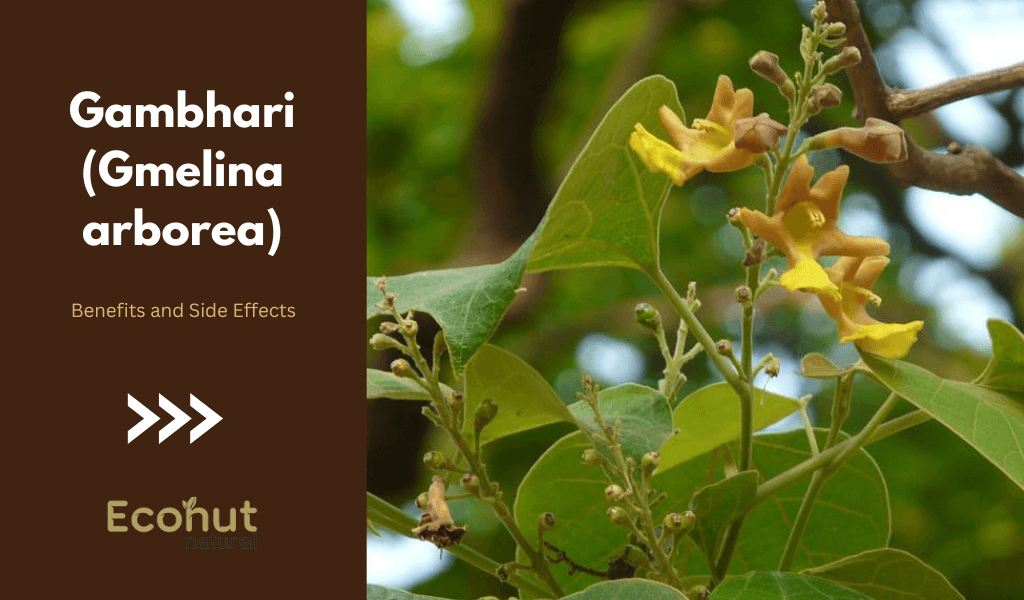Gambhari, scientifically known as Gmelina arborea, is a species of flowering tree belonging to the family Lamiaceae. It is native to tropical regions of Southeast Asia, including countries like India, Myanmar, Sri Lanka, and Thailand. Gambhari is valued for its various uses and is commonly cultivated for its timber, medicinal properties, and ornamental value.
Gambhari (Gmelina arborea) Characteristics
Here, We discuss some of characteristics regarding Gambhari (Gmelina arborea).
Appearance:
Gambhari is a medium to large-sized deciduous tree that can grow up to 30 meters in height. It has a straight trunk with a smooth, greyish bark. The leaves are simple, opposite, ovate to elliptic in shape, and have serrated margins.
Flowers:
The tree produces yellowish-white flowers in clusters, which are fragrant and attractive to bees and other pollinators.
Fruit:
The fruit of Gambhari is a small drupe that is green when young and turns yellow when ripe. It contains several seeds.
Timber:
Gambhari wood is valued for its strength, durability, and resistance to termites. It is commonly used in furniture making, construction, and for making agricultural implements.
Cultural Significance:
In India, Gambhari holds cultural significance and is associated with various religious rituals and ceremonies.
Agroforestry:
Gambhari is also cultivated as an agroforestry species, providing shade to crops and supporting soil conservation efforts.
Gambhari (Gmelina arborea) Classification
| Kingdom | Plantae |
| Class | Angiosperms |
| Sub class | Eudicots |
| Super order | Asterids |
| Order | Lamiaceae |
| Family | Verbinaceae |
| Genus | Gmelina |
| Species | G. arborea |
Other Language Names of Gambhari (Gmelina arborea)
Hindi Name: Gambhara
Telugu Name: Peggumudu
Tamil Name: Umi-thekku
Tamil Name: Gumadi
Malayalam Name: Kumbil, kumbulu, kumilu, kumiska, pokki
Bengali Name: gamar
Punjabi Name: Gambhari
Marathi Name: Shivana
Gujarati Name: Savan
Ayurvedic Properties
Hindi / Sanskrit
- Rasa, Tikta, Kashaya, Madhura
- Guna, Guru
- Virya, Ushna
- Vipaka, Katu
English
- Taste, Bitter, Astringent, Sweet
- Physical Property, Heavy
- Potency, Hot
- Metabolic Property (After Digestion), Pungent
Gambhari (Gmelina arborea) Benefits
Gambhari (Gmelina arborea) is a tree species native to South and Southeast Asia. It has been traditionally used in Ayurvedic medicine for various purposes. Here are some potential benefits regarding with Gambhari:
Medicinal Uses:
In Ayurvedic medicine, various parts of the Gambhari tree, such as the bark, leaves, roots, and fruits, are used to treat a range of ailments. It is believed to have properties that can treat conditions such as diarrhea, dysentery, fever, inflammation, respiratory disorders, and skin diseases.
Anti-inflammatory Properties:
Gambhari is believed to possess anti-inflammatory properties, which may help in reducing inflammation in the body. This property can be useful in treating conditions like arthritis, swelling, and various inflammatory disorders.
Antioxidant Activity:
Studies suggest that Gambhari exhibits antioxidant activity, which can help in neutralizing free radicals in the body. Antioxidants play a crucial role in preventing oxidative stress, which is associated with various chronic diseases, including cancer and cardiovascular disorders.
Antimicrobial Effects:
Gambhari has shown antimicrobial properties against certain bacteria and fungi. This suggests its potential use in treating infections caused by these microorganisms.
Digestive Health:
Gambhari is traditionally used to support digestive health. It may help in improving digestion, relieving digestive discomfort, and treating gastrointestinal disorders such as diarrhea and dysentery.
Respiratory Health:
Gambhari is also used in Ayurveda to treat respiratory conditions such as cough, bronchitis, and asthma. It is believed to have expectorant properties that can help in expelling mucus from the respiratory tract.
Helpful In Wound Healing:
Some traditional uses of Gambhari include applying its extracts topically to wounds to promote healing. Its antibacterial and anti-inflammatory properties may contribute to its effectiveness in wound management.
Immunomodulatory Effects:
There is some evidence to suggest that Gambhari may have immunomodulatory effects, meaning it can modulate the activity of the immune system. This could potentially enhance the body’s ability to fight off infections and diseases.
Anti-diabetic Potential:
Some studies indicate that Gambhari extracts may have hypoglycemic effects, which could be beneficial in managing diabetes. However, more research is needed to fully understand its effectiveness and mechanisms of action in this regard.
Wood and Timber:
Apart from its medicinal uses, Gambhari wood is valued for its strength and durability. It is used in construction, furniture making, and as a source of fuelwood.
Also More: Karavira, Indian Oleander: Uses, Benefits, and Side Effects
Gambhari (Gmelina arborea) Side Effects
This plant is a medicinal plant used in traditional Ayurvedic medicine. It is valued for its various therapeutic properties and is utilized in the treatment of a range of ailments. However, like any medicinal substance, Gambhari may also have potential side effects, especially if used improperly or in excessive doses. Here are some possible side effects regarding with Gambhari:
Allergic Reactions:
Some individuals may be allergic to Gambhari or its components, leading to symptoms such as itching, rash, hives, or swelling.
Gastrointestinal Disturbances:
Excessive consumption of Gambhari may cause gastrointestinal discomfort, including symptoms like nausea, vomiting, diarrhea, or abdominal pain.
Hypotension:
Gambhari has been reported to potentially lower blood pressure. Individuals with low blood pressure should exercise caution when using Gambhari, as it may exacerbate this condition.
Liver Toxicity:
Although rare, there have been reports of liver toxicity associated with the use of Gambhari. Prolonged or excessive use may lead to liver damage in susceptible individuals.
Drug Interactions:
Gambhari may interact with certain medications, potentiating or inhibiting their effects. Individuals taking medications should consult with a healthcare professional before using Gambhari to avoid potential interactions.
Pregnancy and Breastfeeding:
There is insufficient scientific evidence regarding the safety of Gambhari during pregnancy and breastfeeding. Pregnant or lactating women should avoid its use unless advised otherwise by a healthcare provider.
Other Side Effects:
Other potential side effects of Gambhari may include dizziness, headache, fatigue, or allergic respiratory reactions.
Conclusion
Gambhari, scientifically known as Gmelina arborea, is a versatile and valuable tree species. Its wide range of applications in medicine, woodworking, and environmental conservation underscores its significance. With its fast growth and adaptability to various climates, Gambhari presents promising prospects for agroforestry and reforestation initiatives. Overall, Gambhari stands as a valuable asset for both ecological sustainability and economic development.
FAQS
What is Gambhari oil used for?
It has pain-relieving (analgesic) and anti-inflammatory properties which may help with pain caused due to arthritis.
Can Gambhari be used for weight loss?
There is no substantial scientific evidence supporting the use of Gambhari for weight loss. While some traditional medicine systems may recommend it for metabolic health, its efficacy for weight loss specifically has not been well-established through scientific research.
Can Gambhari be used to treat skin conditions?
Gambhari is traditionally used for various skin conditions due to its purported anti-inflammatory and antimicrobial properties. It may be applied topically in the form of creams, ointments, or poultices. However, its effectiveness for specific skin conditions would depend on individual factors and requires further research.
What health conditions can Gambhari be used for?
Gambhari is traditionally used for treating a range of health conditions such as fever, inflammation, pain, diabetes, ulcers, and microbial infections. Additionally, it’s used in the treatment of skin diseases and as a liver tonic.

